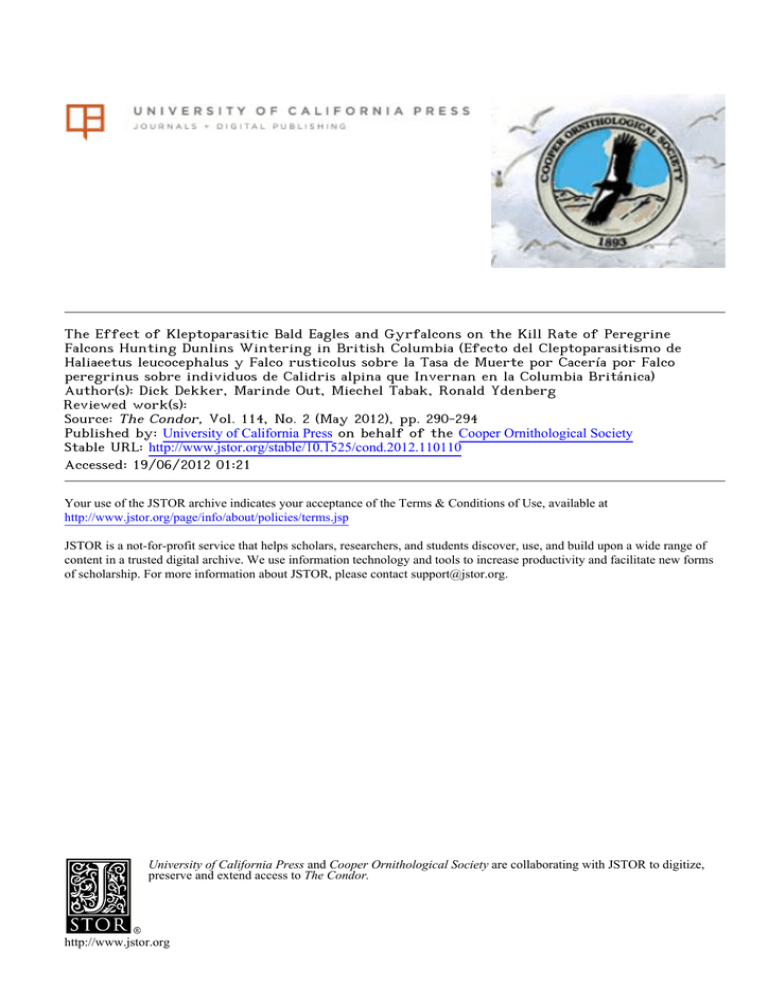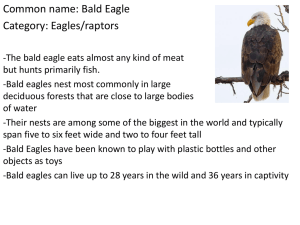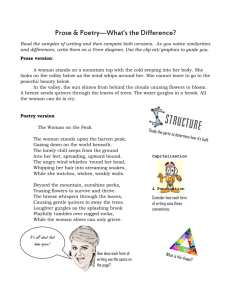The Effect of Kleptoparasitic Bald Eagles and Gyrfalcons on the... Falcons Hunting Dunlins Wintering in British Columbia (Efecto del Cleptoparasitismo...
advertisement

The Effect of Kleptoparasitic Bald Eagles and Gyrfalcons on the Kill Rate of Peregrine Falcons Hunting Dunlins Wintering in British Columbia (Efecto del Cleptoparasitismo de Haliaeetus leucocephalus y Falco rusticolus sobre la Tasa de Muerte por Cacería por Falco peregrinus sobre individuos de Calidris alpina que Invernan en la Columbia Británica) Author(s): Dick Dekker, Marinde Out, Miechel Tabak, Ronald Ydenberg Reviewed work(s): Source: The Condor, Vol. 114, No. 2 (May 2012), pp. 290-294 Published by: University of California Press on behalf of the Cooper Ornithological Society Stable URL: http://www.jstor.org/stable/10.1525/cond.2012.110110 . Accessed: 19/06/2012 01:21 Your use of the JSTOR archive indicates your acceptance of the Terms & Conditions of Use, available at . http://www.jstor.org/page/info/about/policies/terms.jsp JSTOR is a not-for-profit service that helps scholars, researchers, and students discover, use, and build upon a wide range of content in a trusted digital archive. We use information technology and tools to increase productivity and facilitate new forms of scholarship. For more information about JSTOR, please contact support@jstor.org. University of California Press and Cooper Ornithological Society are collaborating with JSTOR to digitize, preserve and extend access to The Condor. http://www.jstor.org The Condor 114(2):290–294 The Cooper Ornithological Society 2012 THE EFFECT OF KLEPTOPARASITIC BALD EAGLES AND GYRFALCONS ON THE KILL RATE OF PEREGRINE FALCONS HUNTING DUNLINS WINTERING IN BRITISH COLUMBIA Dick D ekker1,5, M arinde O ut 2 , M iechel Tabak 3, and Ronald Ydenberg 4 1 3819-112 A Street N.W., Edmonton, AB, T6J 1K4, Canada Augustin Hanicottestraat 15, 1132 XD, Volendam, the Netherlands 3 704-3061 Kent Avenue N.E., Vancouver BC, V5S 4P5, Canada 4 Centre for Wildlife Ecology, 8888 University Drive, Burnaby, BC, V5A 1S6, Canada 2 Abstract. Kleptoparasitism in birds has been the subject of much research, and the Bald Eagle (Haliaeetus leucocephalus) is a known kleptoparasite. It has been reported to pirate ducks captured by Peregrine Falcons (Falco peregrinus), but ours is the first study to examine the effect of kleptoparasitic Bald Eagles on the kill rate of shorebird-hunting Peregrines and indirectly on a population of Dunlins (Calidris alpina) wintering in coastal British Columbia. Bald Eagles increased seasonally and yearly from October 2008 to January 2011. When eagles were scarce, Peregrines hunted ducks as well as Dunlins. Conversely, when eagles were numerous Peregrines hunted Dunlins only. In 56 instances, one or more eagles closely followed hunting Peregrines and retrieved 13 Dunlins dropped or downed by the falcons. The Peregrines were also kleptoparasitized by Gyrfalcons (Falco rusticolus), which pirated 11 Dunlins from Peregrines. Observed losses to kleptoparasites amounted to 24 (36%) of 67 Peregrines’ captures. The kill rate per hour of observation was 0.05 hr –1 in October and November when eagles and Gyrfalcons were few but significantly higher at 0.18 hr –1 during January and February. In January 2011, when intraguild kleptoparasites were most abundant, the Peregrine’s kill rate was 0.30 hr –1. These results support the hypothesis that kleptoparasites had an indirect effect on a population of wintering Dunlins because Peregrines compensated for prey lost to kleptoparasites by increasing their kill rate. Key words: Bald Eagle, Dunlin, Gyrfalcon, kleptoparasitism, Peregrine Falcon. Efecto del Cleptoparasitismo de Haliaeetus leucocephalus y Falco rusticolus sobre la Tasa de Muerte por Cacería por Falco peregrinus sobre individuos de Calidris alpina que Invernan en la Columbia Británica Resumen. El cleptoparasitismo en las aves ha sido motivo de mucha investigación y Haliaeetus leucocephalus es una especie conocida como cleptoparásita. Se ha informado que piratea patos capturados por Falco peregrinus, pero este es el primer estudio que examina el impacto del cleptoparasitismo de H. leucocephalus en la tasa de muerte de aves playeras por parte de F. peregrinus e indirectamente en una población de Calidris alpina que inverna en la costa de la Columbia británica. Los individuos de H. leucocephalus aumentaron estacional y anualmente desde octubre de 2008 a enero de 2011. Cuando las águilas fueron escasas, los individuos de F. peregrinus cazaron patos e individuos de C. alpina. Por el contrario, cuando las águilas fueron numerosas, los halcones cazaron sólo individuos de C. alpina. En 56 eventos, una o más águilas siguieron de cerca halcones que cazaban y recuperaron 13 chorlos arro­jados o derribados por los halcones. F. peregrinus también fue cleptoparasitado por F. rusticolus, quién pirateó 11 individuos de C. alpina a F. peregrinus. Las pérdidas observadas por cleptoparasitismo alcanzaron 24 (36%) de las 67 capturas de F. peregrinus. La tasa de muerte por hora de observación fue 0.05 hr –1 en octubre y noviembre cuando las águilas y los individuos de F. rusticolus eran pocos, pero fue significativamente más alta (0.18 hr–1) ­durante enero y febrero. En enero 2011, cuando el gremio de cleptoparásitos fue más abundante, la tasa de muerte por ­cacería de F. peregrinus fue 0.30 hr–1. Estos resultados apoyan la hipótesis de que los cleptoparásitos tuvieron un efecto ­indirecto sobre una población invernante de C. alpina debido a que los individuos de F. peregrinus compensaron las presas perdidas por cleptoparasitismo incrementando su tasa de muerte por cacería. INTRODUCTION Kleptoparasitism, or food piracy, involves the opportunistic or habitual stealing of food items from other animals, resulting in fitness benefits for the kleptoparasite, which has been the subject of significant effort in modeling (e.g., Ruxton and Broom 1999). The kleptoparasite generally gains by obtaining food that it could not have obtained itself or by saving time and effort in not having to search for that food itself (Shealer et al. 2005). Kleptoparasitism is widespread across Manuscript received 20 July 2011; accepted 13 December 2011. 5 E-mail: ddekker1@telus.net The Condor, Vol. 114, Number 2, pages 290–294. ISSN 0010-5422, electronic ISSN 1938-5422. 2012 by The Cooper Ornithological Society. All rights reserved. Please direct all requests for permission to photocopy or reproduce article content through the University of California Press’s Rights and Permissions website, http://www.ucpressjournals.com/ reprintInfo.asp. DOI: 10.1525/cond.2012.110110 290 Kleptoparasitic Bald Eagles 291 a range of taxa from large carnivorous mammals to arthropods, and it is even practiced as a deliberate foraging tactic by some African tribes (Schoe et al. 2009). Kleptoparasitism is particularly common in waterbirds, including gulls, skuas, jaegers, and frigatebirds (Furness 1987, Calixto-Albarran and Osorno 2000), and it has frequently been reported between open-country Falconiformes (Brockmann and Barnard 1979, Paulson 1985). For instance, of 181 prey-carrying falcons and accipiters observed by Cresswell (2004), 19 (11%) were chased by other raptors apparently intent on kleptoparasitizing that prey. Among raptors, intraguild kleptoparasitism generally benefits the larger species over the smaller species and dominant over subordinate conspecifics. For instance, in Alberta and British Columbia, male Peregrine Falcons (Falco peregrinus) are kleptoparasitized by Buteo hawks as well as by female Peregrines (Dekker 1980, 1995), which are about one-third larger than the males (Cade 1982, White et al. 2002). The inter- and intraspecific kleptoparasitic habits of the Bald Eagle (Haliaeetus leucocephalus) are well known (Palmer 1988, Buchler 2000). Jorde and Lingle (1998) reported stealing fish and waterfowl from other raptors to be a major food-gathering method of Bald Eagles wintering in Nebraska. On the Pacific coast of British Columbia, Peregrine Falcons foraging over the ocean often lose downed seabirds to Bald Eagles (Dekker and Bogaert 1997). On Vancouver Island, Dekker (1995) noted that eagles pirated 13 (28%) of 46 ducks captured by wintering Peregrines, and in central Alberta Dekker and Court (2003) note that Bald Eagles took four (25%) of 16 ducks from Gyrfalcons (Falco rusticolus). After steep numeric declines during the previous century, Bald Eagle populations have dramatically recovered across the Pacific Northwest following decreases in contamination and persecution. Their return has been particularly strong in south-coastal British Columbia (Buchler 2000, Elliott et al. 2011). Nesting territories in the Fraser River delta increased from two in the 1960s to 108 in 2008 (Hancock 2003, Goulet 2009). A 1994–2001 census of wintering Bald Eagles scavenging at the Vancouver regional landfill peaked at 453 in 2001 (Elliott et al. 2006), and the 5-year means of Bald Eagles sighted during the Audubon Christmas Bird Count at Ladner, British Columbia, increased from 241 in 2001–2005 to 665 in 2006–2010. In light of the growing abundance of kleptoparasitic eagles, we examined their indirect effect on a population of wintering Dunlins (Calidris alpina). We hypothesized that predation pressure on the Dunlins increased because losses to kleptoparasitic eagles forced Peregrine Falcons to compensate by killing more Dunlins than their own food requirements demanded. To test our hypothesis we compared the Peregrine’s kill rate per hour by month and year in relation to the presence of avian kleptoparasites. This is the first study to measure the indirect effect of a kleptoparasitic raptor on a prey species it is not known to hunt itself. METHODS The study area is at Boundary Bay in the Fraser River estuary (49° 05′ N, 123° 00′ W) of southwestern British Columbia. The bay is 16 km across, and the intertidal zone is roughly 5 km wide at the lowest ebb. The mudflats are bordered by a strip of salt marsh 0–150 m wide. A gravel road on a dike 2 m high protects low-lying agricultural fields and meadows inland. Boundary Bay is a major stop-over for migratory waterbirds. Dunlins begin arriving at Boundary Bay in October. Estimated at ~40 000, the population does not appear to have changed in recent years, although in late November numbers can be substantially higher than in midwinter, particularly during periods of freezing temperatures (Ydenberg et al. 2010). The only other shorebird to winter in some numbers (~1000) is the Black-bellied Plover (Pluvialis squatarola). Some 50 000 ducks, mainly Mallards (Anas platyrhynchos), Northern Pintails (A. acuta), American Wigeon (A. americana), and Green-winged Teal (A. crecca), congregate in late summer and stay well into March. Bald Eagles and other raptors occur year round. For a more detailed description of the Fraser delta and its avifauna, see Butler and Campbell (1987). From 2006 to 2011, DD spent part or all of 74 days in the area for a total of 494 hr divided over six study periods: 9–28 January 2006, 21–28 October 2006, 4–15 February 2008, 19–24 October 2008, 8–21 November 2009, and 16–30 January 2011. Between November 2009 and January 2010, MO made a daily census of Bald Eagles simultaneously in binocular view from a central point on the dike. We recorded additional data on the local Bald Eagle population in January 2011 by counting eagles perched along the tide line and on the cross bars of a 2-km line of wooden power poles running parallel to the dike. From September to April, 2006–2011, MT visited the study area one to three times per week to find and photograph Gyrfalcons, which prey on waterfowl (Clum and Cade 1994, Dekker and Court 2003). Peregrines could be individually identified by sex and plumage characteristics (White et al. 2002). The hunting tactics of Peregrines wintering in the study area and the antipredator strategies of Dunlins were described by Dekker (1998, 2003) and Dekker and Ydenberg (2004). In this study we followed the same methods. From a vehicle parked on the dike, we monitored flocks of Dunlins for alarm behavior such as sudden flushing. To discover distant falcons, we frequently scanned the shoreline and ocean through binoculars. We kept perched falcons under observation for varying lengths of time in the hope of seeing them depart on foraging flights, then followed flying falcons in the glasses for as long as they remained visible. We entered sightings of Peregrines and details of hunting activity into a field diary and a coded table. The terms hunt and attack are interchangeable and defined as one completed attempt to capture a prey of which the outcome became known. A hunt or attack could include one or more passes, stoops, or swoops at the same target. At distances of >1 km the 292 Dick Dekker et al . outcome of attacks could not always be determined, and we did not include these hunts in the table. However, if the falcon abandoned its attempt and attacked other prey, the first hunt was obviously unsuccessful. On the other hand, we counted the hunt as having been successful if the departing Peregrine was pursued by one or more other falcons, eagles, or large gulls. Whether or not these potential kleptoparasites succeeded in robbing the Peregrine could be determined by their interactive behavior, even at distances of 2–3 km. All attempts at piracy were recorded and detailed in the field notes. captured by Peregrines were ducks, two of which were subsequently kleptoparasitized by eagles arriving well after the falcons had begun feeding. In addition, during the same month, an eagle pursued a hunting Peregrine and picked up a duck that splashed into the water to evade the falcon. Otherwise, we observed a Peregrine kill a duck only on the rainy afternoon of 19 November 2009, when a female falcon launched a shortrange surprise attack and seized a duck just as it flushed from a puddle in the salt marsh. On 56 occasions, one or several Bald Eagles (up to nine simultaneously) interfered with Peregrine Falcons engaged in close pursuit of Dunlins or while carrying captured Dunlins to be plucked. The eagles succeeded in 13 (23%) instances, either retrieving the downed Dunlin from the water or catching it in mid-air after the Peregrine released its prey. Six Dunlin-hunting or Dunlin-carrying Peregrines were harassed by large gulls and Northern Harriers (Circus cyaneus). In one of these cases, a downed Dunlin was seized by a harrier, which subsequently lost it to an eagle. Bald Eagles also kleptoparasitized Gyrfalcons and were seen to pirate 12 just-captured ducks from Gyrfalcons. Probably to avoid detection by eagles, Gyrfalcons generally hunted very low over inland fields and along drainage ditches. We did not observe Gyrfalcons hunting Dunlins actively, but, with the objective of piracy, Gyrfalcons sometimes joined Peregrines that were engaged in close pursuit of Dunlins. Gyrfalcons that perched on poles along the dike appeared to be on the lookout for hunting Peregrines. In 12 instances, Gyrfalcons pursued Dunlin-carrying Peregrines for distances of 1–3 km over the ocean and commandeered at least 11 of their prey. To quantify kleptoparasitic pressure on the Peregrine’s predation rates, we compared the rate of Dunlins killed per hour of observation by season and by year. In January and February, the kill rate was 0.18 hr –1, significantly higher (χ2 = 14.62, df =1, P < 0.001) than the 0.05 hr –1 recorded in October and November (Table 2). In January 2011, when eagle numbers were highest, Peregrines killed Dunlins at a rate of 0.30 hr –1. RESULTS Peregrine Falcons were present in the study area throughout our study. On the basis of territorial and aggressive interactions we assessed their number at three adults and one to four immatures. One territorial Gyrfalcon and one or more transients were seen from mid November onward. Bald Eagles increased seasonally and yearly. Mean daily counts ranged from 2 in October 2006 and 2008 to 6 in November 2009, 22 in December 2009, and 54 in January 2010 (Table 1). On 22 January 2011, 142 Bald Eagles were in simultaneous view along a 4-km section of the study area. Peregrine Falcons launched 449 attacks on Dunlins, resulting in 67 (15%) captures (Table 2). Peregrines hunted ducks only in autumn when eagles were absent or scarce. For instance, from 21 to 28 October 2006, six of eight prey TABLE 1. Bald Eagle numbers simultaneously in view from one spot on the dike at Boundary Bay, British Columbia. Bald Eagles counted Month October 2006–2008 November 2009 December 2009 January 2010 Observation days Range Mean 14 14 17 14 0–6 2–8 5–60 16–94 2 6 22 54 Total 29 78 377 762 TABLE 2. Comparison of the kill rate of Peregrine Falcons hunting Dunlins in October and November, when Bald Eagles were scarce, to the kill rates in January and February, when they were numerous. Observation effort and hunting activity 21–28 Oct 2006 19–24 Oct 2008 8–21 Nov 2009 Totals 9–28 Jan 2006 4–15 Feb 2008 16–30 Jan 2011 Totals Days Hr Hunts Kills Hunts hr –1 Kills hr –1 Presence of kleptoparasites 8 6 14 28 19 12 15 46 48 41 88 177 129 78 110 317 12 31 44 87 117 60 185 362 2 4 3 9 16 9 33 58 0.25 0.76 0.50 0.49 0.91 0.77 1.68 1.14 0.04 0.10 0.03 0.05 0.12 0.12 0.30 0.18 Low Low Low Low High High High High Kleptoparasitic Bald Eagles 293 DISCUSSION Hunting Peregrines lost 36% of their Dunlins (24 of 67) to eagles and Gyrfalcons. On the basis of the following calculation, the indirect effect of these kleptoparasites was even higher. When eagles and Gyrfalcons were absent or scarce, the Peregrines hunted mainly ducks and killed Dunlins at a rate of 0.05 hr –1. When kleptoparasites were abundant, Peregrines killed Dunlins much more often, at a rate of 0.18 hr –1. Of this total, 0.13 kills hr –1 (0.18 – 0.05) or 72% are therefore indirectly attributable to the presence of kleptoparasites. The changes in kill rate were not attributable to changes in the populations of ducks or Dunlins, which remained the same throughout the study. The crucial role of the Bald Eagle in the relationship is underscored by the fact that the Peregrines captured seven ducks and nine Dunlins in October and November, when eagle numbers were lowest, but stopped hunting ducks and captured only Dunlins after eagles became numerous. As speculated by Dekker (1980, 2003), it is possible that duck-hunting female Peregrines shift their foraging activities inland or wait for nightfall after eagles retire to a roost. During the current study, however, we often observed female Peregrines hunting Dunlins by day. In addition, they were frequently seen to kleptoparasitize male Peregrines, forcing them to kill again. To escape from kleptoparasites, some male Peregrines consumed their prey while soaring or sailing high above the ocean (Dekker 2009). Captive Peregrine Falcons require 100–150 g of meat per day (White et al. 2002). Wild Peregrines probably consume more than inactive captives, and the incidence of surplus killing and waste can be high. For instance, in Alberta and British Columbia, migrating and wintering falcons captured one to three ducks per day, eating only part of the neck and breast meat and leaving much of the carcass to scavengers and other raptors (Dekker 1987, 1995). If Peregrines are discouraged from hunting ducks and instead have to catch Dunlins, weighing about 50 g each, they must consume several to meet their daily needs. We saw both male and female Peregrines hunt again or chase prey-carrying conspecifics immediately after having consumed one Dunlin (see Dekker 1999). Assuming that the study area was hunted over by six Peregrines, of which three were female and three male, their combined dietary needs should amount to 21 Dunlins per day (four each for females and three each for the males). Based on our findings that 24 of 67 Dunlins were lost to kleptoparasites, the required minimum kill should be raised by 36%, which brings the calculated total of six Peregrines up to a minimum of 28 per day. The above estimated daily kill of Dunlins should be taken as a minimum, given that other species of birds take Dunlins as well and because our observations were centered on a 4-km section of a bay 16 km wide. During our study, we noted a total of six Dunlins seized by Merlins (Falco columbarius), harriers, and Glaucous-winged Gulls (Larus glaucescens). In addition, Bald Eagles caught two Dunlins directly upon flushing them from the mud flats at close range. As well, in January 2006, we noted two accidental deaths, likely caused by collisions within the flock but indirectly attributable to fear of predators. Both mortalities happened during the dangerous period just after high tide when Peregrine surprise attacks are most successful and false alarms are frequent (Dekker 1998, Beauchamp 2010, Dekker et al. 2011). As the panicked Dunlins flushed in a compact flock from the shoreline, one bird dropped out and fell back onto the water, weakly thrashing about or floating on the surface as if dead. Both casualties were at once picked up by eagles that had been watching from a power pole on shore. Bald Eagles also kleptoparasitized Dunlin-hunting Merlins and harriers (Dekker 2003). Our findings that Gyrfalcons habitually kleptoparasitized Peregrines is indirectly linked to the Bald Eagle. Having just lost a captured duck to an eagle, a hungry Gyrfalcon can be expected to be more inclined than a satiated one to launch a long pursuit of a Peregrine carrying prey. The seasonal increase we observed in eagle numbers parallels data presented by Elliott et al. (2006), who timed the eagle’s autumn arrival in relation to salmon availability in streams from Alaska to northern Washington. The yearly increase in wintering Bald Eagles we observed is reflected in the Audubon Christmas Bird Count at Ladner, British Columbia, which includes part of Boundary Bay. Rising from a mean of 665 from 2006 to 2010, the Ladner count reached an all-time record of 1198 in 2011. In January 2011, M. Tabak (unpubl. data) estimated eagles scavenging at the Vancouver regional landfill at ~1200, as compared to 453 in 2001 (Elliott et al. 2006). In conclusion, we suggest that the increase of the Bald Eagle has major implications for the winter ecology of the Dunlin and raptors at Boundary Bay and perhaps elsewhere. Elliott et al. (2011), who quantified the dramatic fluctuations of the Bald Eagle population in the Pacific Northwest, listed nine reports of declines in waterfowl and gull populations attributed to the increase in the Bald Eagle. We add a hitherto unreported indirect effect on a population of wintering shorebirds, through the eagle’s interference with the prey selection of falcons. How Peregrines will eventually react to harassment by eagles is a matter for further study. In Alberta, Dekker (1999, 2009) reported migrating Peregrines to start hunting ducks at nightfall, apparently to avoid kleptoparasitic Buteo hawks. At Boundary Bay, as we report here, Peregrines refrained from capturing prey they could not carry out of reach of pursuing kleptoparasites, whereas they often ate light prey on the wing. Eventually, if eagle numbers increase further, some or most Peregrines may leave Boundary Bay to hunt inland or over the ocean. As we have noted, Gyrfalcons did not capture ducks on the outer coast in full view of the eagles. Instead, they hunted very low over inland fields and along ditches. In Alberta, wintering Gyrfalcons stopped hunting ducks on farm lands when Bald Eagles were watching (Dekker 2003). 294 Dick Dekker et al . Interestingly, Elliott et al. (2011) suggested that eagle populations in the Pacific Northwest have stabilized, and that they are limited by density-dependent declines on the breeding grounds and by increased adult mortality due to a supply of salmon reduced in late winter. By the same token, declining runs of spawning salmon may have contributed to the 2011 increase in eagles wintering at Boundary Bay, leading to more competition for food and a heightened tendency to kleptoparasitize falcons. ACKNOWLEDGMENTS Partial remuneration of DD’s travel expenses was provided by the Centre for Wildlife Ecology at Simon Fraser University, Burnaby, British Columbia, and by the Canadian Wildlife Service’s research station at Delta, British Columbia. We thank Metro Vancouver Regional Parks Authority for a research permit and vehicular access to the Boundary Bay dike road. Marius Dekker was consulted for the statistical test. David Bird and Will Cresswell supplied relevant literature. Three anonymous referees made helpful comments that improved earlier versions of the manuscript. LITERATURE CITED Beauchamp, G. 2010. Determinants of false alarms in staging flocks of Semipalmated Sandpipers. Behavioural Ecology 21:584–587. Brockmann, H. J., and C. J. Barnard. 1979. Kleptoparasitism in birds. Animal Behavior 27:487–514. Buchler, D. A. 2000. Bald Eagle (Haliaeetus leucocephalus), no. 506. In A. Poole and F. Gill [eds.], The birds of North America. Birds of North America, Inc., Philadelphia. Butler, R. W., and R. W. Campbell. 1987. The birds of the Fraser River delta. Populations, ecology, and international significance. Canadian Wildlife Service Occasional Paper 65. Cade, T. J. 1982. The falcons of the world. Cornell University Press, Ithaca, NY. Calixto-Albarran, I., and J. L. Osorno. 2000. The diet of the Magnificent Frigatebird during chick rearing. Condor 102:569–576. Clum, N. J., and T. J. Cade. 1994. Gyrfalcon (Falco rusticolus), no 114. In A. Poole and F. Gill [eds.], The birds of North America. Academy of Natural Sciences, Philadelphia. C resswell , W. 2004. Kleptoparasitism rates and aggressive interactions between raptors, p. 805–814. In R. D. Chancellor and U. Meyburg [eds.], Proceedings of the 6th World Conference on Birds of Prey. World Working Group on Birds of Prey and Owls, Berlin. Dekker, D. 1980. Hunting success rates, foraging habits, and prey selection of Peregrine Falcons migrating through central Alberta. Canadian Field-Naturalist 94:371–382. Dekker , D. 1987. Peregrine Falcon predation on ducks in Alberta and British Columbia. Journal of Wildlife Management 51:156–159. Dekker, D. 1995. Prey capture by Peregrine Falcons wintering on southern Vancouver Island, British Columbia. Journal of Raptor Research 29:26–29. Dekker, D. 1998. Over-ocean flocking by Dunlins (Calidris alpina) and the effect of raptor predation at Boundary Bay, British Columbia. Canadian Field-Naturalist 112:694–697. Dekker, D. 1999. Bolt from the blue. Hancock House, Surrey, BC. Dekker, D. 2003. Peregrine Falcon predation on Dunlins and ducks and kleptoparasitic interference from Bald Eagles wintering in British Columbia. Journal of Raptor Research 37: 91–97. Dekker, D. 2009. Hunting tactics of Peregrines and other falcons. Ph.D. dissertation, Wageningen University, the Netherlands. Hancock House, Surrey, BC. Dekker, D., and L. Bogaert. 1997. Over-ocean hunting by Peregrine Falcons in British Columbia. Journal of Raptor Research 31:381–383. Dekker, D., and G. Court. 2003. Gyrfalcon predation on Mallards and the interaction of Bald Eagles wintering in central Alberta. Journal of Raptor Research 37:161–163. Dekker, D., and R. Ydenberg. 2004. Raptor predation on wintering Dunlins in relation to the tidal cycle. Condor 106:415–419. Dekker, D., I. Dekker, D. Christie, and R. Ydenberg. 2011. Do staging Semipalmated Sandpipers spend the high-tide period in flight over the ocean to avoid falcon attacks along shore? Waterbirds 34:195–201. Elliott, K. H., J. Duffe, S. L. Lee, P. Mineau, and J. E. Elliott. 2006. Foraging ecology of Bald Eagles in an urban landfill. Wilson Journal of Ornithology 118:380–390. Elliott, K. H., J. E. Elliott, L. K. Wilson, I. Jones, and K. Stenerson. 2011. Density-dependence in the survival and reproduction of Bald Eagles: linkages to chum salmon. Journal of Wildlife Management 75:1688–1699. Furness, R. W. 1987. Kleptoparasitism in seabirds, p. 77–100. In J. P Croxall [ed.], Seabirds: feeding ecology and role in marine ecosystems. Cambridge University Press, Cambridge, England. Goulet, R. 2009. Aspects of the ecology of urban-nesting Bald Eagles in south-coastal British Columbia. M.Sc. thesis. McGill University, Montreal, QC. H ancock, D. 2003. The Bald Eagle in Alaska, British Columbia, and Washington. Hancock House, Surrey, BC. Jorde, D. G., and G. R. Lingle. 1988. Kleptoparasitism by Bald Eagles wintering in south-central Nebraska. Journal of Field Ornithology 59:183–188. Palmer, R. S. 1988. Handbook of North American birds, vol. 5. Yale University Press, New Haven, CT. Paulson, D. R. 1985. The importance of open habitat to the occurrence of kleptoparasitism. Auk 102:637–639. Ruxton, G. D., and M. Broom. 1999. Evolution of kleptoparasitism as a war of attrition. Journal of Evolutionary Biology 12:755–759. Schoe, M., H. H. Delongh, and B. M. Croes. 2009. Humans displacing lions and stealing their food in Benoue National Park, north Cameroon. African Journal of Ecology 47:445–447. Shealer, D. A., J. A. Spendelow, J. S. Hatfield, and I. C. T. Nisbet. 2005. The adaptive significance of stealing in a marine bird and its relationship to parental quality. Behavioral Ecology 16:371–376. White, C. M., N. J. Clum, T. J. Cade, and W. G. Hunt. 2002. Peregrine Falcon (Falco peregrinus), no 660. In A. Poole and F. Gill [eds], The birds of North America. Birds of North America, Inc., Philadelphia. Ydenberg, R. C., D. Dekker, G. K aiser, P. C. Sheppard, L. EvansOgden, K. R ickards, and D. B. Lank [online]. 2010. Winter body mass and over-ocean flocking as components of danger management by Pacific Dunlins. Biomedical Ecology 10:1. <http://www.biomedcentral.com/1472-6785/10/1>.







